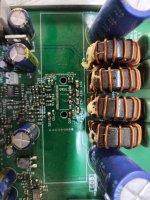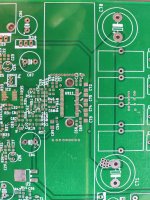I've played with a few TI ClassD amp chips over the past few years, starting off with TPA3221 and then TPA3255. I never could get the latter to give me the SQ I was looking for, no matter how many caps I put on its supply rails. TPA3221 though delivered the goods, at least until my eval module blew up, just it didn't have vast reserves of power. TPA3223 is rather like a TPA3221 but with a higher maximum rail voltage (42V) so should comfortably do 50W/8R. However no-one to my knowledge has done a commercial board for this though there is now a finished amp on Taobao and Aliexpress : https://www.aliexpress.com/item/1005006344550432.html. The TI eval board is prohibitively expensive so I figured I would need to design my own - wifey helped by laying out the PCB. I soldered up the first prototype this morning - no heatsink as yet as I'm breaking it in gently :

What attracted me to TPA3223 was the absence of on-chip regulators for the various power supplies - there are 3 5V rails to provide. Two of them are coming from LM317Ls and the third has a discrete reg. I have a buck reg stepping down the main rail prior to the linear regs. Idle current for the stereo amp is below 40mA from 30V which is impressively efficient compared to my TDA8932 amps which take 60mA per channel from 24V.
What attracted me to TPA3223 was the absence of on-chip regulators for the various power supplies - there are 3 5V rails to provide. Two of them are coming from LM317Ls and the third has a discrete reg. I have a buck reg stepping down the main rail prior to the linear regs. Idle current for the stereo amp is below 40mA from 30V which is impressively efficient compared to my TDA8932 amps which take 60mA per channel from 24V.
Wow! That must be a match made in heaven! 😎wifey helped by laying out the PCB
Jan
Interested.... I love my J Lester Sylph D200 and your monoamps. So this could be a cracking combination.
I was thinking of having a little tinker with my JLE 3255. Bypass the input opamps using a discrete diamond input buffer driving a 10k:10k trafo which would do the SE>diff conversion.
Here are a couple of FFT plots of interest from the TPA3223 datasheet, showing IMD at two output power levels, 1W and 25W. That's a 14dB difference in the reference level (0dB) on the plot.


The 'grass' on the left is a tad below -100dB, that on the right is around -95dB. But when the 14dB difference in reference level is factored in, these two
plots show a ~20dB shift in the noisefloor in going from 1W to 25W output level. The reason I'm showing these is - when wifey listened to the amp she
criticized the seeming lack of audibility of decay tails. She says its like the musical notes don't really 'join up' as they should. I'm wondering if the shift
in the noisefloor with level (aka 'noisefloor modulation') could explain it.
BTW the older TI classD chips (TPA3251, TPA3255) don't have these plots. TPA3221 does and on that chip the noisefloor shift is almost 30dB, take a look:


The 'grass' on the left is a tad below -100dB, that on the right is around -95dB. But when the 14dB difference in reference level is factored in, these two
plots show a ~20dB shift in the noisefloor in going from 1W to 25W output level. The reason I'm showing these is - when wifey listened to the amp she
criticized the seeming lack of audibility of decay tails. She says its like the musical notes don't really 'join up' as they should. I'm wondering if the shift
in the noisefloor with level (aka 'noisefloor modulation') could explain it.
BTW the older TI classD chips (TPA3251, TPA3255) don't have these plots. TPA3221 does and on that chip the noisefloor shift is almost 30dB, take a look:
The noise floor - isn't that the big black bulk in the bottom? If so, it's 12-15 dB - still a lot.
//
//
If you're talking about the TPA3221 plots, there's an offset to add of 14dB to the difference you see between the two. Normally we'd expect the lower signal to have more noise, relatively, than the higher signal level. But this is the other way around - the higher signal level has more noise associated with it. So the noise rises at a rate faster than the signal, about twice as fast.
abraxalito,
What is your impression of the TPA3255? In what aspects is it lacking behind TPA3221/3223?
What is your impression of the TPA3255? In what aspects is it lacking behind TPA3221/3223?
Its going back a few years now but when I had TPA3255 on my bench I couldn't get choral singing sounding right with it. It always added a certain roughness to massed voices, even though I added lots of caps to the supply rails.
I think you may be adding caps in the wrong places on the 3255 if it sounded congested. The output side filter design stock values may have something to do with it. I found that the filter network added by the PFFB really cleans things up, even if you don’t use the feedback part of it. There is a filter mod shown by Bucks Bunny and Voltwide consisting of nothing more than a 20pF cap as feedback post filter really cleaned up the ringing.
Anyhow, neat work on this 3223 chip. You have a wifey who does PCB layouts and I know someone who does PCB layouts who has a wifey who does his 3D CAD. 🙂
Most of us have wifeys who ask “yet another amplifier?” 🙂
Anyhow, neat work on this 3223 chip. You have a wifey who does PCB layouts and I know someone who does PCB layouts who has a wifey who does his 3D CAD. 🙂
Most of us have wifeys who ask “yet another amplifier?” 🙂
Thanks for your encouraging words X.
The TPA3255 I was fiddling with didn't have PFFB, we're going back a few years before any PFFB implementations were commercially available. So perhaps I should give a PFFB TPA3255 a listen. But its not at all encouraging that the DS for TPA3255 doesn't show the FFTs that I've included above.
The TPA3255 I was fiddling with didn't have PFFB, we're going back a few years before any PFFB implementations were commercially available. So perhaps I should give a PFFB TPA3255 a listen. But its not at all encouraging that the DS for TPA3255 doesn't show the FFTs that I've included above.
Hi,There is a filter mod shown by Bucks Bunny and Voltwide consisting of nothing more than a 20pF cap as feedback post filter really cleaned up the ringing.
@bucks bunny , Do you have a link to the quoted filter modification ?
Thanks and Regards,
Shadders.
Bucks Bunny just replied in another thread and posted his schematics and simulations.
https://www.diyaudio.com/community/threads/tpa3255-feedback-questions.406550/post-7563449
https://www.diyaudio.com/community/threads/tpa3255-feedback-questions.406550/post-7563449
I am working on tpa3223. One thing, longer tracks to output filter leads to damage the ic. Also, i am facing tripping issues arround 100watts both channel driven @ 36volts 4 Ohms. Unable to find what issue might be. Have followed evm closely but on a 2 sided board.
Can you be more specific with what blows up?
If you run the amp at high power without a load it can have reflected back emf into the chip. An example is only having one channel connected to a load (mono) but driving stereo.
Or an under-voltage rated or low quality bootstrap cap.
Those are the two cases I have seen where TPA32xx chips have “blown up”.
If you run the amp at high power without a load it can have reflected back emf into the chip. An example is only having one channel connected to a load (mono) but driving stereo.
Or an under-voltage rated or low quality bootstrap cap.
Those are the two cases I have seen where TPA32xx chips have “blown up”.
- Home
- Amplifiers
- Class D
- TPA3223

